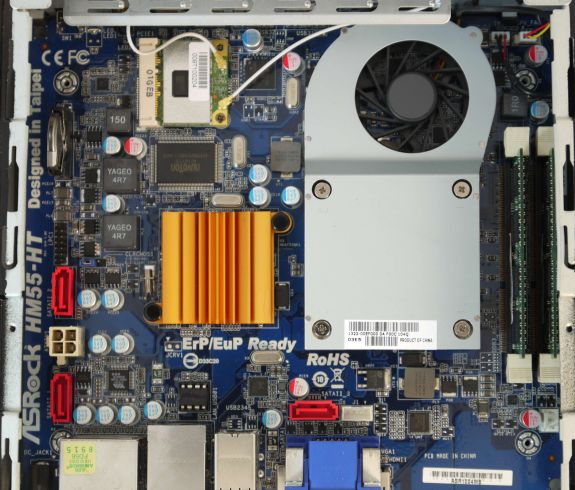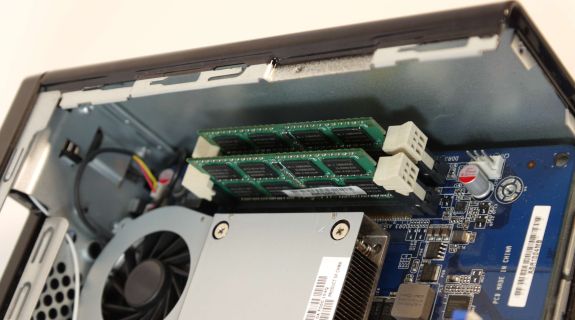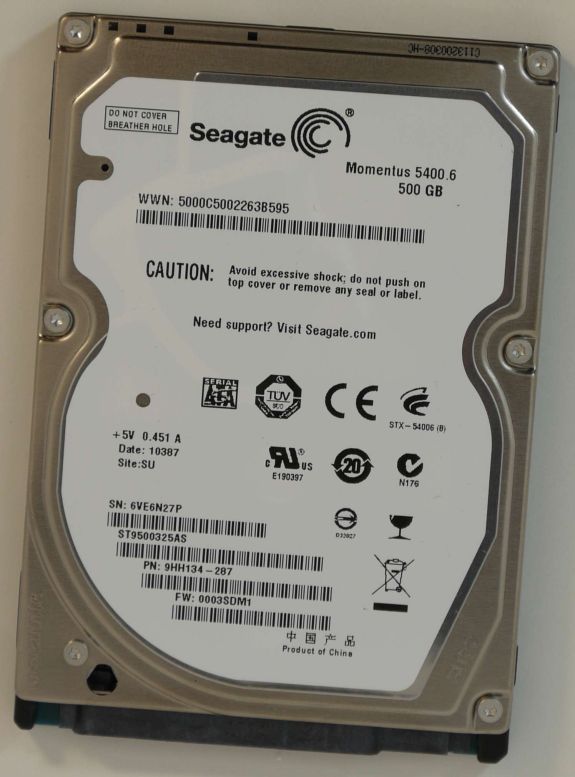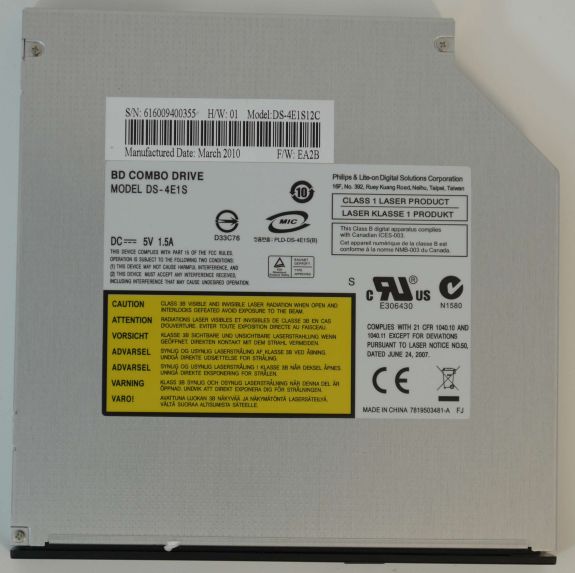ASRock Core 100HT-BD : Bringing HTPCs to the Mainstream Market [UPDATED : Noise Issue]
by Ganesh T S on July 19, 2010 9:34 PM EST- Posted in
- Home Theater
- Arrandale
- ASRock
- Media Streamer
- Core i3
- HTPC
Analyzing the system specifications reveals one clear advantage for ASRock. It is not going to be possible for the average HTPC enthusiast to build a similar system himself with off-the-shelf components. The reason lies in the fact that the Arrandale processor used in the system is currently available for OEM purchase only. All the processors available for general purpose (the Clarkdales) do not fit in the same power envelop as the Arrandales. We covered the Arrandale platform in detail earlier, and concluded that it had a very good power consumption / performance balance. In this section, we will analyze each of the system components in detail.
Motherboard & Chipset: mini-ITX Mobile Intel H55 Express
Over the last 6 months, we have seen many motherboards featuring the H55 chipset. In the mini-ITX form factor, we have covered Zotac's offering as well as Gigabyte's. However, both of them are meant for the desktop Clarkdale processors. What we see in the Core 100 HT-BD is more similar to the motherboards one sees in notebooks. Feature wise, the ASRock motherboard can be compared with the Gigabyte version, since both have support for USB 3.0 ports. However, being a mobile platform, there are some important differences. Tagging on USB 3.0 ports to the HM55 chipset is fraught with issues (more on this in the Performance section). Also, there is no PCI-E x16 slot in the motherboard because the chipset doesn't support it. DVI and PS2 ports are also absent. However, compared to the Gigabyte board, we have two extra USB 2.0 ports. The odd thing to observe here is that ASRock has decided to go with a VGA port instead of DVI, and providing us with a HDMI to DVI adapter, instead of providing a DVI port with a DVI to VGA adapter for folks with older equipment.
Rounding up the other components of the motherboard, we have the Realtek RTL8111E for GbE, and the VIA VT2020 for audio. The mini PCI-E expansion slot is occupied by the Atheros AR9287 module capable of 300 Mbps. As can be seen from the photograph, we have wires connected to the side panels, which act as antennae for the wireless signals. Like many other offerings in the market, ASRock also uses NEC's USB3 controller, giving the system two USB 3.0 ports. Another interesting chip on the board is the Nuvoton NCT6775F. It handles all the sensors (fan speed, temperature etc.) and also the IR support for the MCE remote.
The H55M chipset supports upto 4 SATA ports. In the Core 100 HT-BD, two of them are used by the Blu Ray drive and the hard disk. One of them is free for use by an optional 2nd hard drive (or SSD). The last one is made available as an eSATA port on the back panel. The mini-PCIE slot, as already mentioned, is taken up by the wireless module. In essence, the Core 100-HT BD's motherboard is a notebook motherboard in the mini-ITX form factor.
The Gigabyte mini-ITX (based on the H55) with the USB 3.0 ports can be purchased from Newegg currently for around $100. Since ASRock's version is based on the mobile version of the chipset, and also has a THX certified audio codec chip, the cost is bound to be slightly higher. One must also take into consideration the cost of the Atheros AR9287, which can be bought for around US $15 online. For the purpose of cost analysis, let us assume that one may theoretically be able to purchase a similar motherboard for US $140.
CPU & GPU: Intel Core i3-330M @ 2.13 GHz, iGPU @ 667 MHz
For the form factor and thermal design of the Core 100 HT-BD, only processors with a maximum TDP of 35W are supported. Also, most HTPCs do not require features like Turbo Boost, particularly when their performance exceeds what people have come to expect out of a particular form factor (talking about the Atom nettops) by a magnitude. Keeping in mind the cost of the processors and the nett cost of the system, ASRock has decided to go with the lowest end of the Arrandale spectrum, namely, the Core i3-330M. We feel that this is a very good choice, as the processor is powerful enought for most of today's demanding tasks, particularly from a HTPC perspective.
The integrated GPU is clocked at 600 MHz by default in the system, but it can be easily overclocked to 900 MHz without much effect on fan noise or any concerns about the system heating up. Most HTPC users are more interested in turning down the heat and power consumption. Towards this, attempts are made to undervolt or underclock the CPU. In our opinion, for the Core 100 HT-BD, the savings obtained through these methods are not worth the trouble. Intel's SpeedStep technology is enabled on this system, and we observed that the cores would clock around 940 MHz when doing light browsing tasks, and kick upto 2.14 GHz under heavy load. It is easy to overclock the system too (from within Windows, as well as the BIOS), but the need would probably be never felt in a HTPC usage scenario.
The pricing of the Core i3-330M is available only to OEMs. Our sources, however, informed us that it costs around US $135 in high volume.
DRAM: Elixir Memory's 2 x 2GB Nanya DDR3 @ 1066 MHz
The Core 100 HT-BD has two DDR3 slots, both of which are occupied by the 2 GB Nanya DIMMs. One can potentially use 4 GB DIMMs to get 8GB of system memory, but that would be an overkill from the HTPC perspective. ASRock's choice of 4GB is more than enough for the HTPC.
The 2 DIMMs can be bought currently for around $100 in total from resellers in the US.
Hard Disk: Seagate Momentus 2.5" 5400 rpm 500 GB
Since the form factor of the build indicates that the system is more of a notebook, the hard drive inside is a 2.5" model. ASRock has gone in with the Seagate Momentus 5400 rpm drive. While one might prefer a faster drive for installing the OS, there is no doubt that the lower power consumption of this unit makes it an ideal choice for the HTPC. There is enough space inside the system for an additional 2.5" drive, and filling that up with a SSD would be a great choice for the boot drive. The shipped Seagate drive is ideal and capacious enough for HTPC duties.
The hard drive can be currently had from Newegg for US $65.
Optical Disk Drive: Philips / Lite-On Blu-Ray / DVD RW
The Core 100 HT-BD model ships with the Lite-On DS-4E1S Blu-Ray / DVD RW drive. Again, this is a model meant for notebooks, with the tray not coming out fully when ejected. It can be found online for around $90 without shipping charges taken into consideration.
Miscellaneous Components
The chassis is obviously custom made for this motherboard. ASRock also throws in the SATA, power cables and screws for the optional 2nd hard drive. Mini-ITX cases with PSUs of much higher rating (the unit comes with an external 90W adapter) can be had for around US $50. So, we estimate the cost of the chassis, power adapter and other similar accessories to be around the same. Note that the unit also ships with an IR based MCE remote. Though the build quality of the remote is not high end in nature, we estimate that it adds around $30 to the cost.
Cost Analysis
| ASRock Core 100HT-BD Pricing Analysis | ||||
| Component | Average Price Online | |||
| Motherboard (with mini-PCIe wireless) | $140 | |||
| CPU | $135 | |||
| DRAM | $100 | |||
| HDD | $65 | |||
| Optical Drive | $90 | |||
| MCE Remote & IR Receiver | $30 | |||
| Misc Components (Chassis, Power Adapter, Cables, etc...) | $50 | |||
| Total Cost to Build | $610 | |||
| ASRock Core 100HT-BD Estimated Cost | $700 | |||
Newegg is supposed to have this HTPC for sale soon around the $700 price point. (The model with the DVD drive instead of the Blu-Ray is already on sale for $650.) With only a $90 premium over a home built HTPC, this is not a bad investment from the value viewpoint. Do note that the cost of the OS and keyboard / mouse have to be added on to this to get a sense of the true cost of the system. Also, we still have to take a look at the unit from various other perspectives. Read on to find out more.














107 Comments
View All Comments
GreeneEyez - Tuesday, July 20, 2010 - link
Have fun bitstreaming HD audio from the Mac Mini or playing back Blu ray disks/ISOs...ganeshts - Tuesday, July 20, 2010 - link
GeorgeH,It is not possible for any home built mini-ITX box to be within the power envelop of this unit.
This uses an Arrandale processor which isn't available for purchase by the general public.
Further, as you rightly observe, the MacMini has worse specs, but looks better. Companies like ASRock provide the best bang for the buck, and in this pursuit, industrial design takes a back seat. However, things are going in the right direction, and I am sure the execution next time around will be much better from all perspectives.
softdrinkviking - Tuesday, July 20, 2010 - link
i need a tv tuner in or connected to my htpc.you say that the 100HT-BD's chipset cannot support an internal TV tuner, but that it has a smaller power envelope than a chipset which can.
in that case, you would also have to factor in the extra power used by your external TV tuner box.
you would also have to compare the cost of that box versus the cost of a tuner card.
if all things are equal (you break even), then the all-in-one solution (a beefier htpc) would be the obvious choice.
tmservo - Tuesday, July 20, 2010 - link
As others mention, since the MacMini doesn't do Bluray, and doesn't bitstream DTS-MA or DD-HD, it's not really a great HTPC. It's LPCM support also troubled, and it doesn't matter since it doesn't do Bluray. The MacMini simply isn't a very good HTPC at all. It might compete against something like an ION.. except you can get an ION with BD at 1/2 the price. Apple has to give up rejecting the "bag of hurt" that is bluray, because as long as they keep their phobia of it, they aren't in the HTPC market at allComputer Bottleneck - Tuesday, July 20, 2010 - link
It will be interesting to see your future evaluation of the AMD IGP in the HQV 2.0 benchmark.As far as this product goes I really liked reading your technical explanation of how Asrock integrated what is basically a laptop mainboard into the Mini-ITX form factor.
alaricljs - Tuesday, July 20, 2010 - link
Can I suggest in that HTPC centric features chart that under SPDIF you specify optical/copper instead of just yes/no?ganeshts - Tuesday, July 20, 2010 - link
Thanks for your suggestion, alaricjls.The SPDIF is optical, and I will update the article shortly.
dbone1026 - Tuesday, July 20, 2010 - link
Hey Ganesh,Excellent job with the review. Honestly I am surprised by some of the comments regarding an expansion slot, which to me defeats the whole purpose of ASRock making this HTPC in such a small form factor. Aside from USB tuners I know many people who use network tuners (i.e HDHomeRun) so in many cases there is no need for any sort of internal tuner. If want to strap on multiple tuners then why not just a MicroATX or ATX case as that is not the intention of this ASRock..
I honestly think the biggest challenge with the ASRock 100HT is the price. Newegg has it listed at $649 (without BR drive) and no O/S. The mini-ITX HTPC I built which was only slightly larger and was easily $100 less with better specs (using core i5). Hopefully we start seeing prices drop soon.
jabber - Tuesday, July 20, 2010 - link
I've been rolling out the dual core Atom ones for small office/home PCs. The customers love them over the old big black/grey boxes.Low power and small desk presence are a big win.
Very nicely made too.
Built about sixteen of them and not one issue so far.
erictorch - Tuesday, July 20, 2010 - link
The core i3-330m processor is available for ordering from www.superbiiz.comIf the reviewer reads this comment, can they comment on whether AHCI support is available in the BIOS menus? This is necessary to get the full performance out of a SSD. A lot of laptop bioses don't have AHCI selectable.